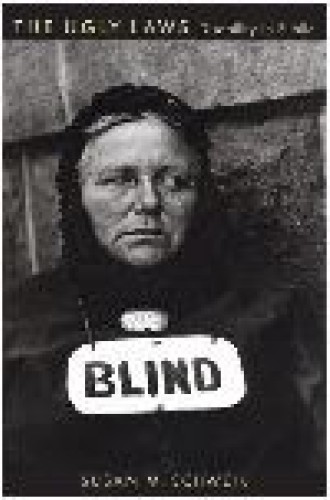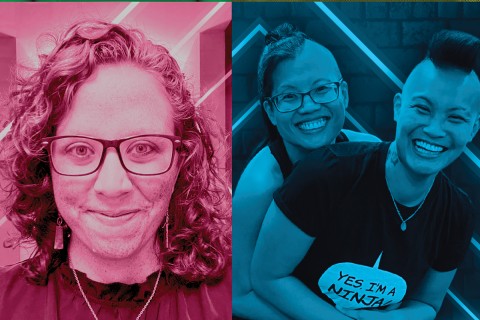The Ugly Laws: Disability in Public
When I first moved to one of California’s beautiful seaside cities, a friend from a less self-consciously glamorous part of the country asked as she watched the young and fit lounging on the grass under palm trees, “Where are all the ugly people?” The question tapped depths she hardly dreamed of. Little did she—or I—realize at the time how many forces were at work to make sure that “ugly people” are out of sight and comfortably out of mind.
Periodically American cities make efforts to “clean up the streets.” Invoking ordinances against loitering or panhandling, police round up the indigent and homeless—the tired, the poor, the “wretched refuse” of our teeming sidewalks—and direct them to shelters, social service agencies, or jail cells where they’re held for minor offenses. Sometimes such efforts generate a flurry of controversy: some people campaign for more affordable housing and emergency services; others put signs in store windows urging shoppers not to encourage panhandling; still others hold picnics for the homeless in city parks.
Many of us who enjoy the privileges of food and shelter are troubled by the plight of visibly poor people, especially if they are dirty, deranged or disabled. Many of us respond by participating in food distribution or lobbying for policy changes. But even those of us who are ethically sensitive may find our hopes for a more just economy diluted on occasion by fear or “compassion fatigue.” The fifth or sixth time we are accosted and asked for money as we do an errand or go out for an evening’s entertainment, we may well find our interest in the larger issues giving way to more immediate personal concerns.
Less obvious than the plight of people in the streets are the legal constraints that often keep them in a cruel double bind—faultlessly vulnerable and punishable for their vulnerability. Even those who have paid attention to discrimination against the disabled may find in Susan Schweik’s history of “ugly laws” some disturbing surprises.
The ambiguous term Schweik borrows for her title comes from a landmark 1975 work of legal scholarship by Marcia Pearce Burgdorf and Robert Burgdorf Jr. It refers to ordinances against exposing “unsightly” bodies and engaging in embarrassing public behaviors associated with mental illness.
Communities’ efforts to sequester various forms of human misery have a long history, dating back at least to 1867 in the U.S. The passage of a San Francisco ordinance that year criminalizing the “display” of certain “offensively” visible disabilities for purposes of begging was preceded by the work of a citizen “Vigilance Committee” that sought to impose “moral order” by regulating “distasteful” public behaviors. Aimed at “certain persons” who should not be “at large” and needed to be “cared for”—a euphemism legitimized by the establishment of almshouses, which justified “street cleaning”—the laws drew some of their power from the ambiguity that left judgment to the beholder. It was impossible to know how unsightly one had to be to violate them, but the sensibilities of socially advantaged beholders were implicitly deemed normative.
Schweik pays particular attention to how the language of the ugly laws, which were widespread by the 1880s, worked to establish behavioral norms that disenfranchised the disabled: “‘Diseased’ carries associations with the social and the moral; ‘maimed’ seems to gesture clearly toward the environmental, ‘deformed’ toward the congenital; ‘unsightly’ minces in the realm of the genteel, ‘disgusting’ gets visceral.”
Highly charged terms like these tended to confuse care with control and to conflate “hygiene, morality, and Americanization.” They also conflated disability, socioeconomic status and race, so that persons who were visibly different—poor, nonwhite, foreign-born or disabled—suffered from the effects of fear by association. All were regarded as threats to the health and well-being of others. What they chiefly threatened, Schweik points out, was “the myth of self-made success.”
Whether one was “copper” (in the color-coding of the city’s almshouse records) or “Coolie” or “Native-Born” white made a difference in the sorting, determining how someone . . . would be defined (as infirm or disgustingly diseased), construed (as pitiable or deplorable), and disposed of (in jail or in quarantine or exile or given over to the harsh charity of the almshouse).
An important feature of Schweik’s argument is that ugly laws emerged as a direct function of capitalism. Unsightliness, she points out, was “illegal only for people without means.” Most of these statutes thinly masked anxiety about begging, since to see beggars is to become uncomfortably aware of one’s own vulnerability to the slings and arrows of fortune, and perhaps less confident of one’s self-sufficiency. Schweik devotes a whole chapter to the paradox in which many were caught when they sought to overcome the disenfranchisement of “ugly laws” by writing and peddling their own stories. This work made it hard to classify them as beggars, but being licensed peddlers, they remained vulnerable to losing their licenses, and therewith their voices and status as workers.
An embarrassing dilemma for the arbiters and enforcers of ugly laws emerged when wounded soldiers returned from the Civil War and other wars. Respect for soldiers’ sacrifice conflicted with the impulse to put them out of sight and mind. Though early iterations of “ugly laws” made explicit allowances for veterans—even those who begged and exhibited their wounds in public—later codes and practices retreated on that front. One New York newspaper argued that real veterans had “liberal provision” from the government—“enough, surely, to render . . . mendicancy inexcusable.” Recent controversies over the funding of mental health care for veterans and officialdom’s nervous efforts to deny or disguise the effects of Gulf War syndrome indicate how strong the inclination is to avoid recognizing the systemic issues that underlie some of the human misery we may find distasteful.
This book is, as Schweik convincingly characterizes it, “a history of the harm done by—let us allow the phrase some force—lack of regard.” It provides useful background for understanding current efforts to encode and enforce protections for the disabled and disadvantaged. And the dark legacy is still playing out: disabled people “continue to experience discrimination in a wide range of areas, including the built environment, the labor market, education, welfare, health and support services, literature, the media and the leisure industry.”
Practices and attitudes follow law, sometimes at a considerable distance. Though disability awareness has come a long way, we might do well to ask ourselves where we find those who are not fully fit. If they are on our sidewalks, how did they get there? And if they are not, where are they and on whose terms?






